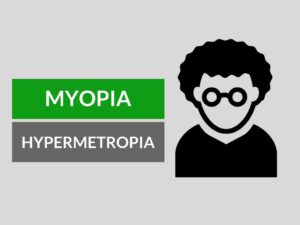Difference Between Myopia and Hypermetropia
What is Myopia?
Myopia, commonly known as nearsightedness, is a refractive error of the eye where distant objects appear blurry while close objects can be seen clearly. It occurs when the eyeball is longer than normal or when the cornea is too steep, causing light to focus in front of the retina instead of directly on it.
Examples of Myopia:
- Squinting while trying to read a road sign from a distance.
- Having difficulty seeing objects or people clearly in a classroom or during meetings.
Uses of Myopia:
Myopia can be advantageous in certain activities such as reading, computer work, or any task that requires close-up vision. Many skilled professions like doctors, artists, or researchers benefit from the ability to see minute details up close.
What is Hypermetropia?
Hypermetropia, commonly known as farsightedness, is a refractive error of the eye where close objects appear blurry while distant objects can be seen clearly. It occurs when the eyeball is shorter than normal or when the cornea is too flat, causing light to focus behind the retina instead of directly on it.
Examples of Hypermetropia:
- Struggling to read a book or newspaper without holding it at an arm’s length.
- Experiencing eyestrain or headaches when working on tasks that require close-up focusing.
Uses of Hypermetropia:
Hypermetropia can be advantageous in activities that require good distance vision, such as outdoor sports, driving, or recognizing people from a distance. It allows individuals to see far objects more clearly without the aid of corrective lenses.
Differences Between Myopia and Hypermetropia:
| Difference Area | Myopia | Hypermetropia |
|---|---|---|
| Definition | A refractive error of the eye where distant objects appear blurry. | A refractive error of the eye where close objects appear blurry. |
| Caused by | Eyeball being longer or cornea being too steep. | Eyeball being shorter or cornea being too flat. |
| Focus of Light | In front of the retina. | Behind the retina. |
| Objects Visibility | Clear near objects, blurry distant objects. | Blurry near objects, clear distant objects. |
| Need for Corrective Lenses | Required to improve distance vision. | Required to improve near vision. |
| Risk Factors | Reading excessively, genetic predisposition, lack of outdoor activities. | Age, family history, chronic health conditions. |
| Corrective Measures | Glasses, contact lenses, or refractive surgeries like LASIK. | Glasses, contact lenses, or refractive surgeries like LASIK. |
| Prevalence | More common in younger individuals. | More common in older individuals. |
| Symptoms | Squinting, eyestrain, headaches, difficulty in seeing distant objects. | Eye fatigue, blurred vision, difficulty in reading. |
| Treatment Timing | Treatment can be done at any age. | Treatment may be required after the age of 40. |
Conclusion:
In summary, myopia and hypermetropia are two common refractive errors of the eye that result in blurred vision. While myopia affects distant vision and hypermetropia affects near vision, both conditions require corrective measures like glasses or surgery to improve visual acuity.
People Also Ask:
Q1: Can myopia or hypermetropia be treated without glasses?
A1: Yes, refractive surgeries like LASIK can correct myopia and hypermetropia, reducing or eliminating the need for glasses.
Q2: Are myopia and hypermetropia hereditary?
A2: Yes, there is a genetic predisposition for both conditions. If parents are nearsighted or farsighted, their children are more likely to develop the same refractive errors.
Q3: Can myopia or hypermetropia worsen over time?
A3: Yes, both conditions can worsen during childhood and adolescence. Regular eye examinations and appropriate corrective measures can help control their progression.
Q4: Can myopia or hypermetropia be prevented?
A4: While refractive errors cannot be entirely prevented, certain measures like regular breaks from close work and spending time outdoors can help reduce the risk of developing myopia.
Q5: Can myopia or hypermetropia affect only one eye?
A5: Yes, it is possible for one eye to be myopic or hypermetropic while the other eye has normal vision. This is known as anisometropia.


